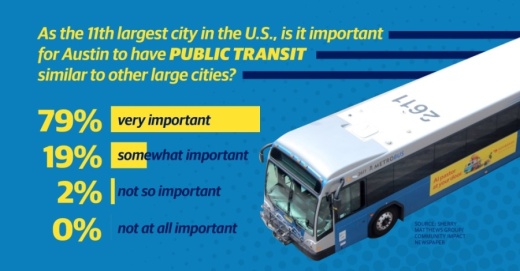The process leading up to a June 10 vote adopting a new plan to revamp the public transportation map in the Austin region, add three light rail lines and expand Capital Metro's bus lines officially started in 2018 when Capital Metro adopted a vision map. However, the discussion in the community goes back decades. After unanimous votes to support the plan, called Project Connect, every member of the City Council and the Capital Metro board said this time around, the moment feels different.
Eric Stratton, the Williamson County representative on Capital Metro's board and the president of Williamson County Republican Leaders, said he has opposed proposals that have come together in the past because he saw them as piecemeal and not well thought out. This time, he said he has no qualms about supporting the plan.
"I'm excited to see this. It's the best investment for our community. At this point, it's go time," Stratton said.
The vote from the board of directors, which was supported by City Council, officially adopts Project Connect as the transit plan that will be put in front of the community. There are still questions to answer and hard decisions to make, District 6 City Council Member Jimmy Flannigan said, but that should not take away from the gravity of the decision.
"This is a big moment. The city has never had a plan like this," Flannigan said.
The $9.8 billion plan would add three light rail lines. One, the Orange Line, would run between Tech Ridge in North Austin to Slaughter Lane in South Austin. Another, the Blue Line, would connect downtown Austin to the Austin-Bergstrom International Airport, and the third, the Gold Line, would run between Austin Community College's Highland campus and South Austin.
Those lines would run through an underground tunnel downtown to take them away from traffic, and they would converge in some denser sections of the city to provide service every five minutes rather than every 10 minutes, according to Project Connect program manager Dave Couch.
Leading up to the vote, local marketing firm Sherry Matthews Group ran a survey of Austin residents in May to find out their opinions of the plan. Nearly all the residents surveyed—98%—said that as the 11th-largest city in the country, Austin needs to have public transit similar to its peers.
A similar margin, 95% of respondents, had positive views of Project Connect, and while that number dropped significantly when residents considered the property tax implications, 71% said they still support the project with the tax implications taken into account.
Dollars and cents
Now that the plan has been adopted, the next step for local officials will be working out the details of the governance and the financing. A board that includes representation from the city and Capital Metro will oversee the program, but officials have not yet made decisions on how members would be selected.
According to a presentation from Jill Jaworski of PFM Financial Advisors to the board and City Council on June 10, analysis of other projects around the country support an estimate that 45% of Project Connect would be funded by the federal government—or $4.4 billion of the $9.8 billion project.
That leaves $5.4 billion to be funded locally, which would come in part from property taxes. In August, once the city and Capital Metro board determine how much revenue is needed and where the city would need to set the tax rate, City Council could call for a tax rate election, which would ask voters for permission to raise property taxes to bring in the revenue needed to fund the program.
Those numbers still need to be finalized, but on June 10 Jaworski and Greg Canally, Austin's deputy chief financial officer, presented numbers based on an $0.11 increase in the tax rate per $100 of home valuation. For the median homeowner of a $325,000 property, that would translate to a $358 increase annually, or about $30 per month.
Both the city and Capital Metro will next be going to their annual budget reviews in July. Austin City Council has until Aug. 12 to call a referendum, and then the decision would go to the voters in November.
District 1 City Council Member Natasha Harper-Madison said she hopes the community sees through the investment because it would address many "big, overdue changes in Austin" that the city has been fighting to solve for decades
More access to transit, Harper-Madison said, would give Austin's black and brown residents an alternative to car travel and the risk of racially profiled traffic stops, as well as the opportunity to get rid of a car would put money back in the pockets of struggling families.
"For the past 70 years or so, Austin has put all its eggs in one basket and planned its growth around cars. If you don't have a car, you don't get to participate in the economy," Harper-Madison said. "This is the first [plan] I'm aware of that proposes true, meaningful improvements to East Austin, including the eastern crescent and beyond."





